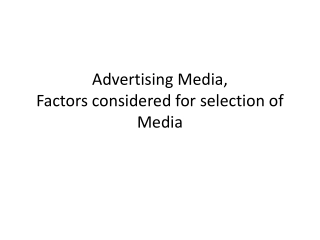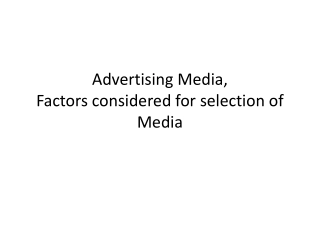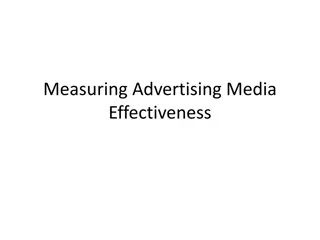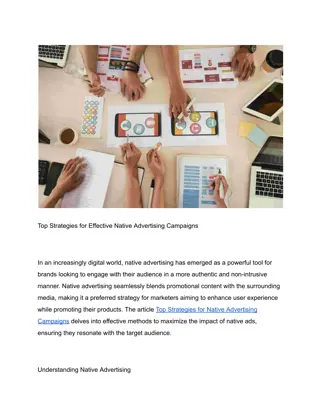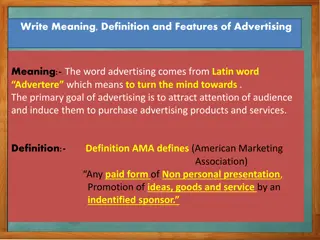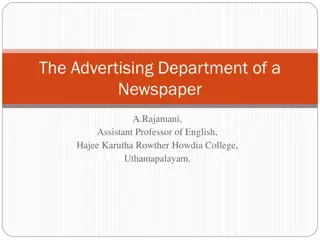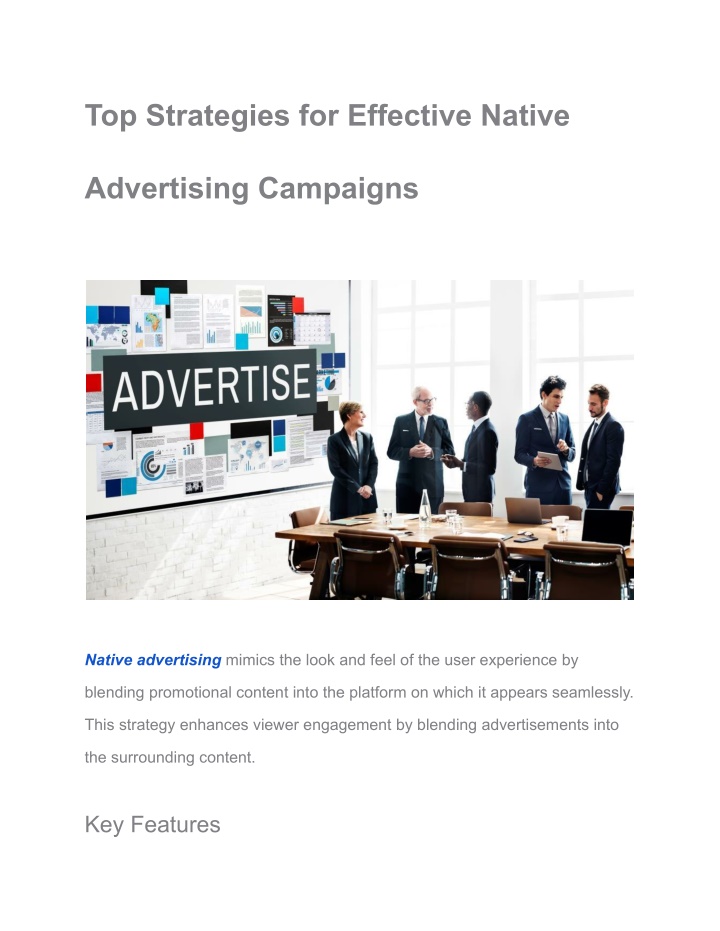
Top Strategies for Effective Native Advertising Campaigns
In the ever-evolving digital landscape, advertising has taken on many forms. One such innovative method is native advertising, which integrates seamlessly into the platforms where it is placed. Unlike traditional ads, native ads match the look and fe
Download Presentation

Please find below an Image/Link to download the presentation.
The content on the website is provided AS IS for your information and personal use only. It may not be sold, licensed, or shared on other websites without obtaining consent from the author. If you encounter any issues during the download, it is possible that the publisher has removed the file from their server.
You are allowed to download the files provided on this website for personal or commercial use, subject to the condition that they are used lawfully. All files are the property of their respective owners.
The content on the website is provided AS IS for your information and personal use only. It may not be sold, licensed, or shared on other websites without obtaining consent from the author.
E N D
Presentation Transcript
Top Strategies for Effective Native Advertising Campaigns Native advertising mimics the look and feel of the user experience by blending promotional content into the platform on which it appears seamlessly. This strategy enhances viewer engagement by blending advertisements into the surrounding content. Key Features
Ad Format: Resembles the look and feel of the platform. User Experience: Offers a non-disruptive user interaction. Content Relevance: Ensures relevancy to the target audience. Common Types 1. In-Feed Ads: Appear among content feeds. 2. Search Ads: Displayed within search engine results. 3. Recommendation Widgets: Suggested content based on user behavior. Historical Context: Evolution of Digital Advertising The history of digital advertising can be traced back to the earliest days of the Internet. Initial forms included banner ads, which first appeared in the mid-1990s. At this stage, advertisers primarily focused on click-through rates as a measure of success. With the advent of search engines, sponsored results emerged, exemplified by Google s AdWords in 2000. Social media platforms like Facebook and Instagram soon followed and revolutionized targeting capabilities through user data. Native advertising entered the scene as a response to ad fatigue and the increasing use of ad blockers. It seamlessly integrates promotional content with editorial, providing value while maintaining user engagement. What Makes Native Advertising Different? Native advertising integrates seamlessly into its platform, offering a non-disruptive user experience. It focuses on providing value through relevant content rather than hard selling. Key differentiators include:
Format Harmony: Matches the form and function of the surrounding content. User Experience (UX): Enhances user immersion by blending in with natural browsing habits. Content Relevance: Aligns with the interests of the target audience. Engagement: Encourages interaction through high-quality, informative content. Transparency: Often labeled as sponsored or promoted to maintain trust. These elements ensure native ads contribute positively to the consumer journey. The Psychology Behind Native Advertising Understanding the psychology behind native advertising is crucial for creating effective campaigns. Several factors influence consumer behavior and perception: Cognitive Fluency: People prefer content that feels familiar and easy to understand. Native ads blend seamlessly with their environment, enhancing their cognitive fluency. Trust and Credibility: Compared to standard advertisements, native ads that imitate reliable journalistic material are more effective at building credibility. Engagement: Users are more likely to engage with ads that appear as organic content, increasing interaction rates. Consumer Journey: Effective native ads guide consumers through various stages of the buying process subtly, aligning with their decision-making patterns.
Benefits of Native Advertising for Brands Native advertising offers multiple advantages for brands striving for impactful marketing. By seamlessly integrating with the surrounding content, native ads provide a more engaging and effective way to reach audiences without disrupting their experience. Key Benefits: 1. Seamless Integration: Non-Disruptive: Native ads blend effortlessly with the content of the platform they appear on, maintaining the look and feel of the surrounding editorial or user-generated content. This seamless integration ensures that the ad doesn t interrupt the user experience, making it more likely to be well-received. 2. Enhanced Engagement: Increased Interaction: Users are more likely to engage with ads that match the format and feel of the content they are already consuming. Native ads often generate higher levels of interaction, including clicks, shares, and comments, compared to traditional display ads. 3. Higher Credibility: Trustworthy Placement: Ads that appear as part of editorial content or within the flow of user-generated content tend to be perceived as more credible and trustworthy. This trust can translate into higher acceptance and engagement rates. 4. Better Ad Performance: Improved Metrics: Compared to standard advertisements, native ads usually have superior engagement metrics and
greater click-through rates (CTR). This performance boost can lead to more effective campaigns and a better return on investment (ROI). 5. Targeted Reach: Precision Targeting: Native advertising allows for precise targeting based on demographics, behavior, and context. Brands can tailor their messages to specific audiences, ensuring that the right people see the right content at the right time. 6. Improved Brand Perception: Enhanced Affinity: The subtlety of native ads can enhance brand perception by delivering valuable content that aligns with the user s interests and needs. This strategy promotes a favorable relationship with the brand and lessens ad fatigue. Additional Advantages: Adaptability Across Platforms: Native ads can be easily adapted to fit various digital platforms, including social media, news websites, and mobile apps, ensuring consistent and cohesive messaging across channels. Content Diversity: Brands can use native advertising to promote a wide range of content types, including articles, videos, infographics, and interactive elements, catering to different audience preferences and consumption habits. Storytelling Opportunities: Native ads provide an excellent opportunity for storytelling, allowing brands to convey their message in a more engaging and narrative-driven format. This can help in building deeper connections with the audience. Measurable Impact: With advanced analytics, brands can measure the impact of native ads accurately, tracking key metrics such as engagement, conversions, and overall campaign effectiveness. It is
possible to continuously optimize and enhance using this data-driven strategy. Case Studies and Examples: Successful Campaigns: Highlighting successful native advertising campaigns can illustrate the tangible benefits. For instance, a case study of a fashion brand that used native ads to seamlessly integrate product promotions within lifestyle articles could demonstrate improved engagement and sales. Industry Insights: Sharing industry insights and trends related to native advertising can help brands understand the evolving landscape and stay ahead of competitors. For example, discussing the rise of native video ads and their impact on user engagement can provide valuable context. Challenges and Criticisms of Native Advertising Native advertising faces several challenges and criticisms: Blurring Lines: Native ads can blur the line between editorial content and advertising, potentially misleading readers. Consumer Trust: Consumer trust can be damaged by deceptive native advertising, which can result in unfavorable opinions of the platform and the advertiser. Regulatory Issues: Ensuring compliance with advertising regulations is a significant challenge, as these rules evolve. Decreased Transparency: When native ads are poorly labeled, transparency diminishes, making it hard for consumers to distinguish them from regular content. Ethical Concerns: Ethical issues arise when native advertising is perceived as deceptive or manipulative.
How to Implement an Effective Native Advertising Strategy 1. Identify Target Audience Conduct thorough market research. Utilize audience analytics. 2. Choose the Right Platform Assess which platforms your audience frequents. Consider social media, content discovery platforms, and news sites. 3. Create High-Quality Content Focus on storytelling and value-addition. Ensure content aligns with the platform s style and user expectations. 4. Integrate Seamlessly Design native ads to blend into the platform s content. Avoid disruptive formats. 5. Monitor Performance Metrics Keep an eye on KPIs like conversion rates, CTR, and engagement. Utilize A/B testing for optimization. Measuring the Success of Native Advertising To determine the effectiveness of native advertising, various key performance indicators (KPIs) should be monitored. Key metrics include: 1. Click-through Rate (CTR):
Measures the percentage of clicks on the ad relative to impressions. 2. Engagement Rate: Evaluates user interactions such as likes, shares, and comments. 3. Conversion Rate: Monitors the proportion of users who finish a desired task. 4. Time Spent on Content: Analyzes the duration users engage with the advertised content. 5. Brand Lift: Assesses changes in perception and awareness. Regularly reviewing these metrics will ensure campaign effectiveness and optimal ROI. Future Trends in Native Advertising Anticipating future trends in native advertising requires an understanding of evolving consumer behaviors and technology advancements. Key trends include: 1. Increased Personalization: Leveraging data analytics to create targeted and engaging content, tailored to individual consumer preferences. 2. AI and Machine Learning: Utilizing AI for real-time content optimization, improving relevance and engagement rates. 3. Interactive Content: Incorporating elements such as quizzes, polls, and AR/VR experiences to foster interactive user engagement. 4. Cross-Platform Integration: Ensuring seamless delivery of native ads across various digital platforms and devices. 5. Blockchain Technology: By using blockchain technology for safe ad transactions and data verification, advertising may become more transparent and trustworthy.
Native Advertising vs. Traditional Advertising Native advertising mimics the layout and aesthetic of the platform, blending in seamlessly with the content it appears inside. Because it adds value without detracting from the user experience, it frequently results in better engagement. In contrast, traditional advertising, such as banner ads or TV commercials, is identifiable and tends to disrupt. Key differences include: Format: Native ads match the platform; traditional ads stand out. Engagement: Native advertising generally has higher engagement rates. Perception: Consumers often view native ads as more trustworthy. Cost: Traditional ads can be more expensive due to production and airtime costs. Impact on User Experience Native advertising s impact on user experience is multifaceted: Relevance: Ads blend into the content, making them more relevant. Engagement: Higher engagement through non-intrusive formats. Trust: Builds trust as they are less disruptive. Content Quality: Enhances user experience if the ad content is high quality. User Control: Users feel in control as they can engage at their discretion. Consistency: Maintains the website s aesthetic and functionality. Negative aspects include potential deception if ads are not clearly labeled. Proper execution ensures a positive user experience.
Best Practices for Native Advertising Understand the Audience: Investigate the target population in depth. Create High-Quality Content: Give important and interesting information first priority. Ensure Contextual Relevance: Align ads with the platform s content. Maintain Transparency: To foster trust, make sponsored material clearly identifiable. Optimize for Mobile: Design ads to be mobile-friendly. Use Eye-Catching Visuals: Add eye-catching pictures or videos. Monitor Performance Metrics: Track key performance indicators. Experiment with Formats: Test different native ad formats to maximize engagement. Leverage Data Analytics: Use insights to refine strategies. Integrate Seamlessly: Ensure ads blend naturally with editorial content. Ethical Considerations in Native Advertising Brands must ensure transparency when creating native ads to avoid misleading consumers. Disclosures like Sponsored or Ad should be clear and prominent. Key ethical principles include: Honesty: Ads should not deceive readers by mimicking editorial content. Relevance: Native ads must offer genuine value or information to the audience. Disclosure: Proper labeling to distinguish native ads from editorial content. Privacy: Avoid using personal data without consent.
Adhering to these principles helps build trust and long-term relationships with consumers, enhancing the overall effectiveness of native advertising campaigns. The Role of Influencers in Native Advertising Campaigns Influencers play a pivotal role in native advertising due to their established trust and rapport with their audiences. Leveraging influencers can amplify the reach and effectiveness of native ads: Authenticity: Influencers present content in a relatable manner, increasing ad credibility. Engagement: Higher engagement rates are often seen due to influencers loyal followings. Targeting: Allows for precise audience targeting based on followers demographics. Content Creation: Influencers craft visually appealing content tailored to their fans. Amplification: Influencer shares can lead to viral spread, maximizing ad visibility. Influencers act as intermediaries, making native ads seamless and effective.


